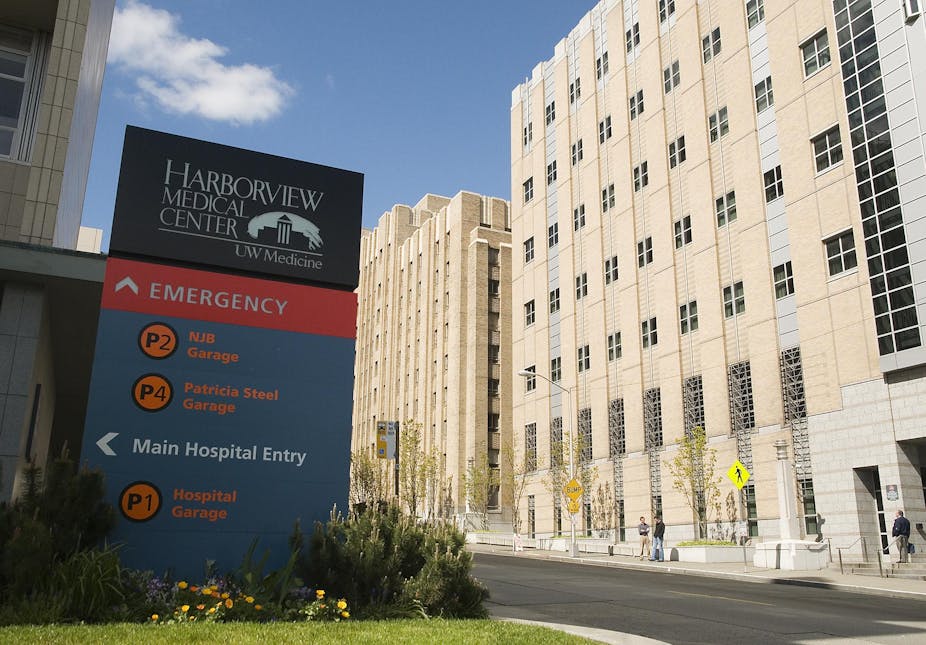The Conversation is running a series of dispatches from clinicians and researchers operating on the front lines of the coronavirus pandemic. You can find all of the stories here.
Inside, as usual, patient beds are near capacity, and the emergency department is filled with not only the usual mix of patients with trauma, stroke, chest pain and other concerns, but also dozens of people worried they might have COVID-19.
I am an emergency and critical care physician who cares for patients in the emergency department and intensive care units at Seattle’s Harborview Medical Center, a public hospital with 413 beds owned by King County and staffed by doctors from the University of Washington School of Medicine. UW Medicine has seen dozens of COVID-19 cases since the first patient arrived here in late February.
Everything feels different in the hospital now. Door entrances are locked, streets outside are quiet, the building feels empty given the lack of visitors and outpatients but also bustling with a different kind of energy.

As emergency and critical care doctors and nurses, we think about and train for these types of situations regularly, but nobody expects to be the epicenter of a pandemic in the U.S. But here we are, and as a result, my colleagues and I have been working to find out ways to help not only our patients but also other doctors around the country who will soon experience what we have, if they haven’t already.
Within a few days at Harborview, we went from normal operations in late February to thinking about how to protect ourselves, our colleagues and our patients with every encounter. Every time I see a new patient, the first question I ask myself, regardless of why they come in, is: “Could this be COVID-19?”
If the answer is yes, I begin the laborious process of “donning” personal protective equipment, moving the patient to one of our few isolation rooms, and then “doffing,” or removing, personal protective equipment. These words were barely in my lexicon two weeks ago. My biggest fear is missing a case and potentially exposing hundreds of other health care workers and patients. In the last week, I have found myself putting on personal protective equipment for almost half of all patient encounters.
In the emergency department, this means not only having suspicion with every cough and runny nose, which are so common this time of year, but also considering whether patients who come in after car crashes, falls or even cardiac arrest may also be infected. This is in direct tension with the knowledge that resources, like personal protective equipment, testing and isolation rooms, are finite.
In the ICU, under normal conditions, the most rewarding parts of my job are spending time at the bedside with critically ill patients and having deep conversations with families, learning about the patient and what they value. This not only helps me make medical decisions in line with what my patients care about, but it also allows me to form important human connections that make the job enjoyable.
These interactions are deeply difficult now and often relegated to brief visits in full personal protective equipment or phone interactions. Instead of sitting face to face with patients, I now call their cellphones from outside of their room, making a personal connection that much harder. Face-to-face family meetings have been moved to telephone or telemedicine as well. Being in the ICU is lonely enough for patients; but that feeling of being alone has to be that much more profound with visitor limitations and health care workers having to take extra precautions to keep themselves safe.
My colleagues and I are worried, but in odd ways unique to health care providers who tend to worry about others more than themselves. I’m more worried about running out of protective gear or getting sick and not being able to take care of patients. I’m also worried about bringing the virus into my home, where I have a 1-year-old daughter and a 4-year-old son. Fortunately, children have not yet been heavily impacted by this disease, but my 70-year-old mother also lives with my wife and me, and she is in a higher-risk age group.
After hearing about health care providers getting sick, I, like many of my colleagues, have reminded my spouse about my preferences if I were to become critically ill.
In these challenging weeks, one thing I did not expect was the overwhelming number of emails and texts from friends and colleagues throughout the country, who recognized that, while Seattle was first, their day with COVID-19 was soon to come.
As a result, several colleagues and I began to collect “lessons learned” on our department’s website. Fortunately, UW Medicine has also been generous about sharing all of our protocols so that others can benefit from our experience. Some of these are basic, like training everyone to use personal protective equipment, but the number of guidelines and protocols that we’ve had to rapidly develop has been staggering, such as changing how we safely place breathing tubes without exposing ourselves.
To the public, I want everyone to know: We’re ready for this and we’re here for you, but we cannot do it alone. We need your help in so many ways.
Our health system is already taxed and busy; our hospital runs over 100% capacity most days, even before COVID. Please follow local public health guidelines about social distancing and hand hygiene.
Please do not use or buy personal protective equipment. Not only is it generally not effective when reused, but it is in short supply. Donate it to health facilities if you have it. If we get sick, we can’t care for you.
Lastly, be kind and patient. We’re in this for months, at best. We need all the support we can get.
[Get facts about coronavirus and the latest research. Sign up for our newsletter.]

